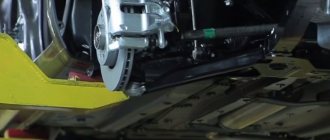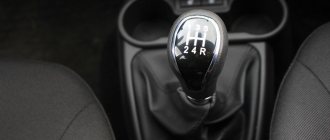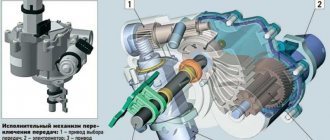Two years ago, a new product from the domestic AvtoVAZ, the Lada Vesta with a robotic gearbox, went on sale. The engineers abandoned the classic torque converter (Jatco JF414E) due to its high cost and lack of a production platform for maintenance.
AMT - this is how “robot” is designated; it was developed by the domestic design bureau of AvtoVAZ based on the mechanical type of ZF class gearbox. Of course, in terms of gear shift speed, AMT is inferior to foreign analogues from Europe and America, but it looks quite decent on the Russian market.
LADA Vesta is equipped with AMT paired with a 1.6-liter / 106-horsepower and 1.8-liter / 122-horsepower power unit. The price per copy varies from 640,000 to 850,000 rubles. AMT is also installed on Vesta SW and LADA Vesta Cross with an engine capacity of 1.8 liters. Starting price from 705,000 rubles.
New technologies in domestic production
Buyers choosing a new car look thoughtfully at the new AMT from Lada. What is it, what is its operating principle? In fact, this is a regular manual transmission, only it does not have a clutch pedal. Instead of three levers, you only get two - gas and brake. The compact gearbox has off, on and shift modes, which replace the familiar pedal.
Reviews of the Lada Vesta robot show that not everyone liked the manufacturer’s innovations. The automated gearbox is developed on the basis of the manual transmission of VAZ cars. The control system uses the latest ZF developments, which help to change gears faster. In terms of quality, the new AMT is clearly better than the old technologies on the Lada Kalina, but at the same time inferior to European analogues (BMW, Ford, etc.). What positions are there on the shift lever in the new Lada Vesta?
- Auto mode – allows you not to think about changing gears at all.
- Neutral position is acceptable when the car is parked.
- Reverse – in this position, as you might guess, the car will go backwards.
- Manual shift - allows you to change gears yourself if you want to overtake someone or save fuel. If you want to downshift, then you don’t have to touch the lever at all - the Lada itself will do everything for you if you take your foot off the gas pedal.
Gearbox robot
The Lada Vesta car uses a robot as an automatic transmission. It is really difficult to say why the engineers of the automobile concern chose this particular option, because there are now a large number of torque converters from various manufacturers on the market.
The concern's designers took the VAZ gearbox as the basis for the AMT (robot), in contrast to the mechanical transmission of this model, which uses a unit from Renault. In general, this is a conventional mechanics on which an electronic control unit has been installed. The use of this box is determined more by price than by other factors. The AMT gear lever does not have a parking position, only reverse gear, neutral gear, automatic mode (something like drive) and manual shifting. The interesting thing is that when changing gears manually, you cannot engage reverse or go into neutral. Forward gears are used.
What is the difference between AMT and automatic transmission?
How does the robot on the Vesta work and how does it differ from a car with an automatic transmission? In terms of structure, it is designed exactly the same as a manual transmission. A robotic one has little in common with an automatic transmission. If in a conventional automatic transmission the torque is transmitted from the engine to the wheels by a torque converter, then in a robotic gearbox the torque is transmitted through gears. The robot was made on the basis of a VAZ mechanical transmission. The AMT consists of the mechanical box itself, the clutch and the electronic unit that controls it.
When developing the new box, engineers from the Tolyatti plant used the experience of foreign manufacturers. And the clutch included in the AMT package is made in France. The part is protected by a wear compensation function that prevents premature failure. There have not yet been any cases of warranty claim registered.
Many people are perplexed: why can’t an automatic transmission be developed on a Russian basis, because so far no domestic car has such an improvement. The answer is simple: the development of automatic transmissions is possible already on the existing base, which does not yet exist in Russia. And production based on foreign developments will significantly increase the final cost of the car. For comparison, using an automatic machine will cost approximately twice as much as a robot.
While the long-awaited LADA Vesta SW Cross station wagon was wandering around the representatives of our editorial staff, a certain number of impressions had accumulated that Drom.ru would like to share with you. Most of them are positive: we like the bright design, roomy interior, well-designed trunk, decent handling and high-energy suspension. But there are also negative aspects. The main complaints are about the 1.8 engine that did not live up to expectations, the extravagant “robot”, the not very high-quality interior and minor “jambs” in operation. Yes, in general we liked the Vesta Cross, but its shortcomings forced some to lean towards the proven “Koreans”, and others to opt for a used car altogether.
Grigory Aleshker - editor of crossover and SUV tests
Age - 47 years Driving experience - 29 years Drives a Renault 4F4
You should have seen how Grisha is getting ready to film the next off-road test: shovels, cables, hi-jacks, several pairs of boots, buckets, water bottles... You won’t be lost with him!
Lada Vesta SW Cross is the best creation of our automobile industry, which went into series. Delight at first sight! You look and think - well, the domestic automobile industry has risen from its knees, now it will run forward by leaps and bounds, go beyond the border - to conquer “capital countries” like the long-legged Russian beauties, which long ago became, together with the Kalashnikov assault rifle, vodka and black caviar, the calling card of the Soviet Union . Ugh, Russia, of course, is again “carrying me away” to “free times”!
Maybe this is because behind the bright façade of a modern raised all-terrain station wagon, problems with product quality that are so familiar to everyone born in the USSR are still hidden? Why do rough power window buttons scratch your fingers? Why on earth does the new 1.8-liter engine require adding oil between scheduled changes? Why the hell is the AMT “robot”, “sabotaging” every gear shift, constantly setting me up for an accident? What pests of the national economy came up with the menu for the media system? And this cheerful orange interior trim... Make a fool pray to God - he will even hurt his forehead, they crammed “oranges” everywhere, as a result, the “tidy” is almost unreadable, the eyes are dazzled by numerous inserts - “excesses in places” are obvious.
And yet, compared to our brothers in the Renault-Nissan alliance - the “Russified French” - our Vesta SW Cross is more comfortable: its steering wheel is adjustable for reach, and the driver’s seat has a normal backrest profile. The luggage space is downright Scandinavian neatness instead of French sloppiness: all these organizers, curtain shelves... On a broken grader, the heart again skips a beat with delight. Not a single passenger competitor can hit bumps like this, and most crossovers, except for the Duster and the Subaru crossover line, are not designed for such feats.
Vesta SW Cross is an ideal vehicle for the “village”, but the prices are by no means “rural”: from 770,900 rubles for the “base” to 866,900 rubles with a “robot” and a 1.8-liter engine in the top configuration - two-year-old all-wheel drive A 2.0-liter Duster with an excellent 6-speed manual transmission can be found for the same money.
Alexander Tychinin - test editor of Droma
Age - 28 years Driving experience - 10 years Drives a Chevrolet Cruze and BMW 325Ci (E46)
Sasha doesn’t do tests for Drom.ru very often, but you like them all. He can easily explain how a limited slip differential, torque converter or stability control system works, tell you what oversteer and understeer are, and then rush at a brisk pace along any race track.
What appeals to me most about the Vesta SW Cross is that it has a chance to increase the popularity of the station wagon in the eyes of Russians. Because it is no longer possible to look at this dull stream of sedans and crossovers. Choose station wagons: they are not only practical, but also beautiful! In addition, I am very glad that our people will finally be able to switch from “sevens”, “nines”, “tens” and “tags” to cars with a normal level of safety, equipment and convenience. But if you ask me personally, I will answer: “Thanks, no need.”
I will not buy Vesta SW Cross. Not because it has flaws in the interior, but the 1.8 engine drives as if our planet is running out of gasoline. Not because the suspension rattles, but every Vesta that comes off the assembly line rides “specially” because of the floating quality of the components. And not even because it still doesn’t have a normal two-pedal version, and VAZ’s “robot” will bore even the most law-abiding retired car enthusiast. Likewise, I will not take any of the competitors. Yes, Vesta is cheaper. But a price tag of 750–800 thousand, even for a well-equipped and very versatile car, is still a lot. And it doesn’t matter at all whether it’s Vesta, Fiesta, Solaris, Rio, Polo, Rapid or something similar.
Solaris, Rio, Polo, Rapid or Vesta - the cars seem to be quite good, even quite good. But for me this whole class smacks of some kind of hopelessness.
I don’t know how to choose “used” cars, but I still vote for “used”. Fortunately, I have many friends who periodically suggest good options. Two of my cars were purchased this way. And if I needed a car right now, I would wait until the last minute for the next option, I would get by on public transport, but I would not go to the dealer and would not make a down payment for the Lada and its companions, hung with extras.
Irina Zverkova – editor of Drom.ru
Age - 41 years Driving experience - 19 years Drives a Land Rover Defender 110
Irina is a true specialist in the social sphere, insurance and litigation matters. But he also has an excellent understanding of cars, and often helps us in tests.
Delight. Complete delight. The main thing is, of course, the appearance: a very beautiful car! None of my friends believed that this was an AvtoVAZ product. The motor is quite enough for me for everyday life. Inside there are pretty decent materials, complex architecture, excellent visibility and space. The multimedia system - with navigation and clear control logic - easily interfaces with smartphones and shows an adequate picture from the rear view camera. There is enough space in the back for three adult men - tested. Three large bags, bags from the supermarket, a heater and a few more purchases from a hardware store - for repairs at the dacha - easily fit into the trunk. The ideal Russian car?
Not without reservations. I couldn’t find the optimal driving position: I don’t fit the user’s percentile—I’m too small. The screen is not very sensitive and does not respond very quickly to touches, and the performance of the entire system is not up to par. But the most “stupid” thing, of course, is the “robot.” You need to get used to it, especially in city mode with frequent switching. It behaves no less strangely on slopes, allowing the car to roll back. On conditional off-road conditions, the Cross easily overcame a frozen dirt road with a small rut from the Defender, took the ascent to the roadway, and even allowed it to turn around and drive into virgin soil. What else do you expect from a front-wheel drive station wagon?
But one of the most significant caveats is the price. For a generation that remembers the cost of VAZ products 10 years ago, a million rubles is an infinite amount. On the other hand, appearance, comfort and spaciousness of the interior, decent technical characteristics - you have to pay for all this.
Alexey Stepanov - build editor, columnist
Age - 43 years Driving experience - 22 years Drives a Skoda Roomster Scout 1.2 TSI
Formally, Alexey is our “build” and observer. But he still has a whole bunch of responsibilities: buying and repairing dromomobiles, participating in tests and business trips.
Of all the members of the editorial board, it was I who was waiting for the release of the universal Vesta, not only out of professional curiosity. I couldn’t wait: six months ago I exchanged the rather rare Roomster compact van, which had served me faithfully for more than seven years, for an even more interesting and rare Roomster Scout. Maybe for the better? On the other hand, it’s a pity: Vesta SW was the most realistic option to purchase not only one that meets basic life requirements, but also literally a new car. A beautiful, practical, quite comfortable, decently driven, not afraid of our roads and - most importantly - economical to operate station wagon would be just right for me. But…
One of my past acquaintances once explained why he exchanged a new and progressive, but inexpensive and generally poorly developed phone in terms of software for another one - no better in terms of characteristics, but more expensive and of better quality. “Not happy...” Here is Vesta: it seems to have everything - the equipment (some options were not recently available on cars two or three classes higher), the design, and a well-thought-out luggage compartment... Many of the initial shortcomings have been corrected. But I feel uncomfortable in her flat chair. Correct driving habits are spoiled by unclear feedback on the steering wheel. Blocks of buttons and keys vary in pressing force and working strokes - as if they were hastily assembled from different machines. And, of course, unfinished software: engine twitches when driving under tension, “glitches” of the built-in navigator, the climate control and automatic windshield wiper are still not working properly (at the same time, the automatic headlights work just exemplary). And if we add to this the shortcomings of the 1.8-liter engine and the “robot” of our station wagon...
If Vesta SW had appeared, as promised, a year earlier, and I had bought it, then I think I would hardly regret it. Just like now, I don’t regret it when I get to drive an editorial car. But in comparison with Scout, it’s not happy... (((
Andrey Bak - photographer
Age — 37 years Driving experience — 19 years Drives a VAZ-2105 Drift “Zhigulyator”
Who would need our articles without Andrey’s juicy and clear photographs? For many years now, the “pictures” for the Moscow edition of Drom.ru have been his responsibility. Well, he knows so much about cars that you never even dreamed of!
As a car photographer, it is important to me that the car is easy and pleasant to photograph. The most photogenic are expensive and sports cars. You can hardly find such “cuties” in the budget segment. But I spent my two or three days test driving the Cross with great interest, and there was a whole bunch of nice “cards” left on my phone and on the camera: this usually doesn’t happen with other Russian cars. Photographing Vesta Cross is a pleasure. Bright and rich color, pleasant shapes, attention from others - everything was “deliverable” during the shooting. Outwardly, Vesta was definitely a success! And there are almost no questions about the interior, the engine, and the handling: very worthy for AvtoVAZ.
People even began to forget about competitors in the form of Solaris, which until recently were the ultimate dream in their class. Such AvtoVAZ products no longer have to be fiercely defended and explained why they cost as much as a foreign car.
The main “but” in our modification is the robotic gearbox. When trying to actively drive, the “robot” stalls, and the driver is overcome with fear and doubt that with the next peck he may not get through. I couldn't relax with this gearbox. We'll have to wait a little longer until the "machine" becomes a reality.
Alexey Antropov - representative of Drom.ru in the Ural region
Age - 32 years Driving experience - 11 years Drives a Skoda Octavia A5 1.8 TSI and LADA Granta
Block man, rock man. Alexey seems to be able to live in dromomobiles for days. Few people have such experience of driving across our vast Motherland.
After the dull “blonde” sedan, the first and strongest impression is the color! Bright, rich, shimmers in different shades depending on the lighting. What a photo-maniac's dream! But in the cabin, such a color scheme is no longer so much pleasing as it is distracting, and the vigorous lighting - after the pale and green ones in the Vesta-dromosedans - is completely annoying with a riot of colors. It would be better to make the cup holders deeper. And in general, in comparison with the “blonde”, no revolution happened in two years. Still the same... uh, pencil, but from a slightly different angle. But in a “damaged” sedan, the noise is worse, and the suspension rattles more. But the workplace is calmer, and the engine, despite its smaller volume and power, is more responsive and playful.
But the main advantage of Vesta Cross is a station wagon body and a trunk that can be loaded under the roof. But do not forget that you will have to go “deep” for the “spare spare”: you will need to pull out all the luggage, collect all the shelves and organizers, put it all on the dirt road and then get the wheel. Well, then in reverse order, several times, taking into account the stop for tire fitting. Here you have to choose: either load less or take out more.
But the most obvious “evil” is the “robot”, which begins to infuriate you at the very first traffic light. Having gotten used to it, the brain makes allowance for the imperfection of the design used and forces its right foot to play along with the machine in order to somehow smooth out the “special effects”.
Anton Serkov – project manager “Proven Cars”
Age - 28 years Driving experience - 10 years Drives a Toyota Corolla 1.3
Anton helps Drom.ru visitors choose a car with the help of the “Proven Cars” project, which he runs. In addition, a good half of the 100,000 mileage of our Captur is his merit.
With the release of Vesta, AvtoVAZ managed to attract the attention of those who had not even thought about buying a Lada before. Two years later, with the debut of the station wagon, we managed to repeat this. But you can’t fool me, an experienced “pelvic operator”, I can easily identify all the “native” Togliatti features: the howling of the box cannot be hidden behind good sound insulation, pressing the buttons is traditionally followed by the clicking of the switches, and the hastily assembled trapezoid of windshield wipers “pleases” them with the wrong position. Well, hello, Lada!
They say they did a lot of work on the car. It seems to be so: Vesta SW Cross looks like an adult, the suspension is energy-intensive and quiet, and the ergonomics are now an honest C - for VAZ this is a compliment. The car with all its appearance wants to show that the times of garage tinkering are gone, and now there is no need to “carry a sled” - you can just ride for your own pleasure. But, firstly, with a “robot” and a completely damped accelerator, there can be no talk of pleasure, and, secondly, the “party” is now simply moving from the garage to the dealer, who must eliminate the shortcomings you have identified.
However, if you are lucky with a specific example that will not act up (the chance is like winning at a casino), then the car is well worth your attention. Junior trim levels are already equipped with everything necessary, but there is also the opportunity for everyone to overpay for unnecessary “whistles”. At the same time, you feel like an agent of the manufacturer, participating in the endless improvement of the model. Therefore, I personally prefer the Rapid to the Russian station wagon, which, for the difference in price, provides the main thing - the feeling of a car.
Sergey Gusarov - news editor
Age - 30 years Driving experience - 11 years Drives a BMW 325iX (E30)
Our Sergey is always up to date with all the news and significant events in the global auto industry. He is a real automotive encyclopedia!
From the outside, the car is inviting. I want to photograph her from different angles. You can even boast about it to friends who don’t closely follow events in the automotive world, but always have a couple of hackneyed jokes about AvtoVAZ on hand. “Well, look, it turned out to be a normal domestic car,” I want to tell them. And Vesta Cross passengers may well like it. The cabin is spacious and quiet, and the suspension provides an acceptable level of comfort. The interior elements could be nicer to the touch, but this is a budget car.
The engine and gearbox, however, are disappointing compared to industry standards. All the days I got acquainted with the editorial Vesta Cross, I tried to catch with my vestibular apparatus the range in which the motor “travels,” but I was unable to do this. A lot has already been said about “robot” (and not very good). There is a suspicion that choosing a traditional “automatic” would deprive Vesta of a competitive price advantage, and would also force the public to look more closely at other shortcomings that can now be forgiven.
The willingness of Russian buyers to turn a blind eye to the shortcomings of domestic technology, which has been developing over the years, and the monopoly position of a small, but beautiful and quite affordable “all-terrain” station wagon, will most likely make the Vesta Cross a very popular car in the Russian Federation. And, in my opinion, it’s still deserved.
Dmitry Krotov — editor-in-chief of Droma
Age - 39 years Driving experience - 20 years Drives an Alfa Romeo GTV 3.0
Dmitry tries to unite the efforts of all Drom.ru authors, to be demanding of them, but at the same time delicate, to create conditions so that you can read more interesting materials.
Just when my time came to take a ride on the obvious “star” of our automobile industry - Vesta SW Cross, I was “lucky” to find myself behind the wheel of a VAZ-2112. Yes, yes, the same “twelve” that until recently were a dime a dozen on the roads. And I’ll tell you what, dear readers: in this comparison, Vesta is simply an ultra-modern and awesome car in all respects. In this contrast, you immediately understand why a Russian car suddenly came close in price to a million rubles.
Design? Yes, this is the most beautiful car from Russia in the last half century! Salon? There is plenty of space, and the organization of luggage space is absolutely top notch. The Cross drives no worse than the Korean “state employees”, and even if it’s on a dirt road and potholes, it’s not possible to catch up at all. But, unfortunately, not everything is so smooth. The number one disappointment is, of course, the “robot”. Given the largely peripheral distribution of the West, I simply encourage everyone to opt for the “handle” if you do not want to nod your heads at every switch. The second obvious disadvantage is that the long-awaited 1.8 engine does not live up to expectations: neither in terms of traction, nor in fuel consumption, nor in smooth operation. Buy 1.6 - you won’t feel the difference of 16 forces. The third problem is the “cheap” interior compared to the same “Koreans”. Well, the fourth nuance is a carriage and a small cart of small “spliffs”. However, many will object that Vesta Cross is cheaper than the bestsellers in the budget segment.
Your truth. As well as the choice is yours: should you prefer a better packaged and very spacious domestically produced station wagon to the problem-free Solaris, Rio, Polo (underline as appropriate) in poorer versions? If you still decide, then take version 1.6 on the “mechanics”. You'll also save a lot of money.
Have a question about Vesta Cross? Ask Drom and we will find the answer!
Instructions for using a machine with AMT
How to use the new gearbox? Reviews from owners of the Lada Vesta 1.8 robot indicate that you still need to learn how to use the AMT. The car's on-board computer displays information that helps monitor the operation of the transmission:
- Mode (manual/automatic).
- Active transmission.
- Brake pedal activity.
So how do you start a Lada Vesta with AMT? To do this you need to follow a number of simple steps:
- Press the brake pedal.
- Move the shift lever to the neutral position.
- Start the car.
It is important to note that any changes in the position of the selector can only be made while the brake pedal is pressed. If you want to park the car, the manufacturer recommends turning off the engine, leaving the handle in the manual or automatic mode position. Very often, novice drivers have a question: what to do if you get stuck in a traffic jam on a slope? To prevent the car from rolling back, it is permissible to lightly press the gas pedal. When driving on a slope, the robot selects first or second gear so that the engine does not stall.
Another useful feature of LADA with AMT is that it can be started from a pusher. Rope launch is activated at speeds of 7 km/h and above. The car also has a transmission brake function. When rolling down an inclined surface, it is permissible to use the brake pedal for more effective braking. All these useful modes make operating the Lada Vesta with AMT convenient and comfortable.
Possible problems with the robot and the advantages of the box.
The negative attitude of most people towards the AMT transmission is very justified, because many automakers who have used a robotic gearbox in their models can receive a whole list of complaints from car owners. This includes jerking at the most inopportune moment, howling of the transmission with subsequent breakdown and a call to the service center. Transmission manufacturers such as Opel, Ford, Toyota and Honda have tarnished their reputation. European models were slightly better, and the most negative reviews about the robot gearbox were received by the Japanese.
At the same time, with a quiet ride, proper maintenance and adaptation of the AMT to your driving style, the cars were possible to use. At the gearbox of the Lada Vesta robot, a ZF control unit is used, which is well known when using manual transmission automation. At the same time, this is not the best option; Opel and Ford also used gearbox blocks from this manufacturer.
Vesta comes with a robotic gearbox with better and more reliable switching algorithms, due to which the car drives really well.
Pros of a robotic box:
- In order to start moving, you need to move the box to position “A” (automatic mode), thanks to which you avoid overheating of the clutch, unlike, for example, DSG boxes.
- With proper driving and maintenance, the unit will last a very long time, due to a more accurate switching algorithm than a manual gearbox.
- The hard start program and incline assist will help you climb uphill with a loaded car.
- Smooth switching during quiet driving without jerks or joints.
Cons of AMT:
- If you are a fan of active driving, we do not recommend buying a car with a robotic gearbox, since the average gear shift time, as stated by the manufacturer, is about 2 seconds.
- Gear changes during acceleration are accompanied by some pauses.
- If the box is not used correctly, repairs are frequent and not very cheap.
- There are no paddle shifters, instead you have to pull the gearbox lever.
Test drive by specialists
What do professionals say about the robot box in Lada Vesta? You can find many reviews of the new product on the Internet. Most note the slow response of the box during acceleration. Some call the driving style of the Lada Vesta robot a style for summer residents. Slow acceleration of the car contributes not only to fuel economy, but also to passive safety. No matter how hard you try to squeeze out maximum speed in order to overtake three or two cars, it is unlikely that you will be able to do it quickly. True, the car behaves a little more cheerfully in manual mode, in which it is more realistic to squeeze the maximum out of the 1.8-liter engine. But, if you get used to this driving style, you begin to notice the advantages: the parts are made well and do not fail for a long time. Compared to manual and automatic transmissions, AMT provides significant fuel savings.
After the driver presses on the gas and the engine picks up speed, the transmission begins to upshift. The problem is that the robot on the Vesta cannot do this without reducing the thrust. The switching time fluctuates around 2 seconds, which can be quite annoying at first. But you won’t feel any jerks, the clutch is as smooth and comfortable as possible. In the reviews of the owners of the Lada Vesta robot in 2022, you can find a comic name for this driving style - driving a Chinese dummy. Due to the excessively sharp speed difference between first and second gear, Vesta drivers and passengers nod due to uneven acceleration.
But, despite various points of view, most reviews about the Vesta 1.8 robot indicate that the introduction of an automated manual transmission was a big leap forward for the domestic manufacturer. Car enthusiasts hope that the improvements will not end there; Lada engineers will properly finalize the box, and it will be a pleasure to drive. By the way, on the official website of the automaker there is already a survey on what users would like to change in the AMT box. So you should be patient - improvements are just around the corner.
Technical characteristics of Lada Vesta modifications
| Name | 1.6 l 16-cl. (106 hp) 5MT 1.6 l 16-cl. (106 hp) 5AMT | 1.8 l 16 cl. (122 hp) 5MT | 1.8 l 16 cl. (122 hp) 5AMT |
| Wheel formula | 4 / 2 | ||
| Motor location | Front | ||
| Body type / number of seats / doors | Sedan / 5 / 4 | ||
| Base | 2635 | ||
| DSHV | 4410 / 1764 / 1497 | ||
| Clearance | 178 | ||
| Trunk volume | 480 | ||
| Power unit | 21129 | ||
| Supply system | Injection | ||
| Number of cylinders / arrangement | 4 / in-line | ||
| Volume | 1596 | 1774 | 1596 |
| Power | 106 | 122 | 106 |
| Maximum speed | 182 | 186 | 182 |
| Acceleration up to 100 km/h | 11,2 | 12,1 | 14,1 |
| Fuel consumption (G/T/SM) | 9,3 / 5,5 / 6,9 | 9,3 / 6,0 / 7,2 | 9,0 / 5,3 / 6,6 |
| Weight | 1230 | ||
| Volume of the tank | 55 | ||
| Number of gears | 5 | ||
Robot on Vesta: reviews
Drivers online are furiously discussing Lada's innovation. Both experienced drivers and beginners who have previously driven only a manual transmission become participants in the debate. Reviews from owners of a Lada Vesta with a robot indicate that not everyone has an unambiguous perception of this new product. On the one hand, there are no those who are 100% satisfied with the AMT of the domestic manufacturer. On the other hand, is it worth being so critical of the first attempts to automate machine control?
Let's take a closer look. The main thing when buying a Lada Vesta with AMT is to clearly understand who such a car is intended for. First of all, this is a car for a quiet and comfortable ride around the city, and not for racing. Vesta with a robotic gearbox is ideal for city traffic jams. If you are tired of manual gear shifting, but foreign cars with an automatic transmission are not yet available to you, then the new Lada will be an excellent option.
Reviews about the Lada Vesta 1.8 robot show that automatic transmission lovers should not buy a car with AMT. Still, these are two completely different boxes that have little in common with each other. Fast automated transmissions of such giants as BMW or Porsche cannot be compared with the Lada gearbox. They change gears quickly and smoothly, without delay. The robot on the Lada Vesta is more like the AMT of old Japanese cars. Nevertheless, this is an excellent compromise option for those who are tired of riding with mechanics.
Doesn't break anymore
I know firsthand how both options behave. I tested the CVT Vesta in the Caucasus and drove it in Moscow. And I’ve been living side by side with the robotic Vesta for 4.5 years now and have driven more than 90,000 km.
Life together with the robot did not work out right away. It is the driver who must adapt to it, and not vice versa! So, if you are looking closely at the “automated” Vesta of the first years of production (on the secondary market), keep in mind: you need to be a very calm driver with nerves of steel so that the box does not irritate you.
After about a year and a half in Tolyatti, the problem of the rapid death of the clutch was corrected. It turned out to be so gentle that even slow shifts did not help. On my car, the clutch kits lasted 20,000 and 18,000 km, and for some, the first signs of wear appeared after 5000–7000 km!
Now the third, reinforced clutch is coming to an end on the editorial car. You'll be lucky if it lasts 60,000 km (that is, up to 98,000 on the odometer). In general, you need to be prepared for quick repairs - and when buying a used Vesta, I would consider the original factory kit as a minus. Especially if it is an old model.
The Renault-Nissan 1.6 engine (113 hp) lacks a decorative cover. Let be! On a VAZ engine it is attached to flimsy pegs that are prone to getting lost. It does not protect from dirt outside and from engine noise - only decoration.
The Renault-Nissan 1.6 engine (113 hp) lacks a decorative cover. Let be! On a VAZ engine it is attached to flimsy pegs that are prone to getting lost. It does not protect from dirt outside and from engine noise - only decoration.
Interestingly, the clutches of the first and second versions signal wear differently. The old clutch begins to respond with shocks in traffic jams, and the car shakes in convulsions at the beginning of movement. The modernized one behaves intelligently, reminding of wear with exceptionally soft slipping, clearly visible in the timbre of the engine and tachometer readings. Therefore, now I will drive all the way, but I changed the previous sets preventively: I did not have the strength to endure their hysterics.
The nuances of driving the Vesta robot
As with all cars, when driving a Lada robot, there are some nuances that should be taken into account when purchasing. They can be understood most clearly if you read the reviews about the robot on Vesta. For example, the gearbox is sometimes tricky when changing gears. If you are driving in second gear, slowly picking up speed, the robot may misunderstand you and shift to first gear instead of third. This often happens during not very dynamic acceleration.
If you need a faster start, there is a little trick. Usually, when driving on the highway, the robot engages fifth gear. If you press the gas pedal to the floor, the car engages third gear, after which the speed immediately increases. This allows you to overtake on high-speed sections of the road. After completing the maneuver, just release the pedal to its normal state, and the AMT will switch back to 5th gear.
As we have already said, a processor is inserted into the robot on the Lada, which reads the behavior and driving style of the driver and adapts to it. If you want the most dynamic acceleration without jerking, then you can try the following driving style:
- Accelerate without releasing the gas pedal. The robot itself will select the right moment to shift from first gear to second, and then to third. But be prepared for a slight jerk between shifts.
- Once your car reaches a speed of 40 km/h, release the gas pedal slightly. At this moment, the car will smoothly shift gears.
- The same action must be repeated at a speed of about 60-80 if you are going to go even faster.
- If at speed 4 you do not press the gas pedal to the floor, then, most likely, AMT will immediately set speed 5, at which dynamic acceleration is impossible.
- When driving uphill, the robot itself slows down if it becomes difficult for the engine to hold the current gear. For beginners, this nuance is especially good: now your car will definitely not stall while climbing a slope.
You still need to get used to driving a manual automatic transmission, but the convenience and reasonable cost of the AMT completely hides all its shortcomings.
What configuration does the AMT come with?
Lada Vesta with an automated manual transmission is available only in luxury configuration. When purchasing this assembly, you can also purchase a manual transmission, which is standard. But for the robot you will have to pay about 25,000 rubles.
Considering that the price for a Lada Vesta in the maximum configuration exceeds 600 thousand, a reasonable question arises: is the game worth the candle? What advantages and disadvantages can be found in such a supplement?
Advantages and disadvantages of the robot on Vesta
Let's start with the advantages. According to reviews of the robot on Vesta, the machine has the following undeniable advantages:
- Equipped with the “Slope Start Assistant” program – even if you park or get stuck in a traffic jam on a slope, this option will help you avoid rolling back when starting. The gearbox increases speed at the start, the clutch becomes stiffer.
- Increased clutch life - thanks to the soft and smooth operation of the AMT, the service life of the part will be long even with careless driving. The shift box is protected against accidental pressing of the lever: if you start shifting it chaotically, the car simply will not react.
- AMT is adaptive and has 26 behavior patterns that it selects depending on the driver’s behavior. How it works? The program reads how the driver operates the gas pedal and, depending on this, switches the clutch at the right moment.
- Fuel economy is hard to believe, but the robot on the Lada is really more economical than a manual or automatic transmission. Thanks to smooth switching, you can use several times less gasoline.
- AMT consumes less oil than manual transmission - also a significant factor in favor of choosing a new configuration.
Reviews of the robot box on Vesta also show the disadvantages of an automated manual box:
- The absence of a parking mode makes parking more difficult; when parking, it is better to leave the control lever in manual or automatic mode to avoid rolling back.
- Gear changes are jerky - between 1st and 2nd gears there is a decrease in speed, which can noticeably slow down the car.
- Slow acceleration - a car with AMT takes a few seconds longer to pick up speed than a car with a manual transmission.
- The inconvenience of the manual mode is that the gearbox is not designed very well, and this makes manual driving of the car less convenient.
Design features and device of the JR5 Lada Vesta gearbox
The domestic robot largely copies the boxes of the German concern ZF. The AMT actuator consists of:
- clutch activation actuator;
- speed change actuator;
- clutch forks;
- backstage for controlling gears inside the car;
- input shaft speed sensor.
The design of a typical robot with electric drive and a single clutch disc. In Europe and Asia, such technology was abandoned five years ago in favor of preselective models, but on the domestic market this is a new product.
Which is better to choose manual or AMT?
The choice between a manual transmission and AMT should be made with a cool head, having calculated all the pros and cons in advance. On the Internet you can find many good reviews about the mechanics or robot of the Lada Vesta. But most drivers opt for an automated manual transmission. It is much more convenient and economical to use. But lovers of classics and conservatives still prefer the usual mechanics. You can only understand whether a car with AMT is suitable for you or not by trying it in action.











